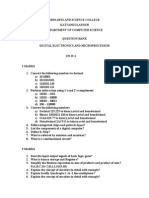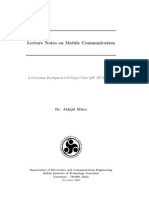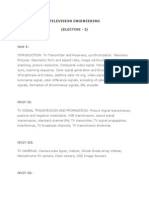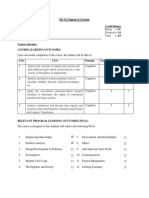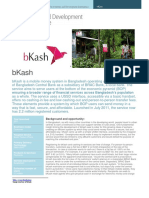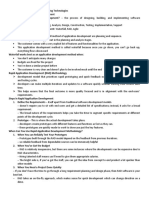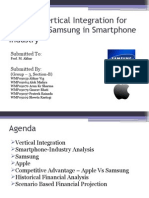Module 1 - Fundamentals of Mobile Communication
Uploaded by
Sudesh AgrawalModule 1 - Fundamentals of Mobile Communication
Uploaded by
Sudesh AgrawalRIZVI COLLEGE OF ENGINEERING
EXTC DEPARTMENT
SUBJECT : MOBILE COMMUNICATION SYSTEM
By Prof. Mohammed Juned
1 Prof. Mohammed Juned RCOE SEM 7 EXTC (MCS)
2 Prof. Mohammed Juned RCOE SEM 7 EXTC (MCS)
Course objectives
To understand the cellular fundamentals and different types
of radio propagation models.
To study the system architecture of 2G, 2.5 G and 3G.
To develop the concepts of emerging technologies for 4 G
standards and beyond.
3 Prof. Mohammed Juned RCOE SEM 7 EXTC (MCS)
Course Outcomes
After successful completion of the course student will be able to :
CO1: Explain the cellular fundamentals and estimate the coverage and capacity
of cellular systems.
CO2: Classify different types of propagation models and analyze the link
budget.
CO3: Illustrate the fundamentals and system architecture of GSM, 2.5G and IS-
95.
CO4:Apply the concepts of 3G technologies of UMTS and CDMA 2000.
CO5:Elaborate the principles of 3GPP LTE.
CO6:Identify the emerging technologies for upcoming mobile communication
systems
4 Prof. Mohammed Juned RCOE SEM 7 EXTC (MCS)
Module Unit No: Topics Hours COs Covered
No:
1 Fundamentals of Mobile 08 CO-1
Communication
Introduction to wire1ess communication:
1.1 Mobile radio telephony, Examples of Wireless
Communication Systems, Related design
problems.
The Cellular Concept System Design
Fundamentals:
Frequency Reuse, Channel Assignment
1.2 Strategies, Interference and System Capacity,
Trunking and Grade of Service, Improving
Coverage and Capacity in Cellular Systems
5 Prof. Mohammed Juned RCOE SEM 7 EXTC (MCS)
Module No: Unit No: Topics Hours COs Covered
2 Mobile Radio Propagation : 08 CO-2
2.1 Large scale fading: Free space propagation model, the
three basic propagation mechanisms, reflection, ground
reflection (two-ray) model, diffraction, scattering, practical
Link budget design using path loss models
2.2 Small scale fading: Small scale multipath propagation,
parameters of mobile multipath channels, types of small-
scale fading, Rayleigh and Ricean distributions.
2.3 Features of all conventional multiple access
techniques: Frequency division multiple access(FDMA),
time division multiple access(TDMA),space spectrum
multiple access (SSMA), space division multiple access
(SDMA),OFDM-PAPR,OFDMA
6 Prof. Mohammed Juned RCOE SEM 7 EXTC (MCS)
Module No: Unit No: Topics Hours COs Covered
3 2G Technologies 10 CO-3
3.1 GSM:GSM Network architecture, GSM signalling
protocol architecture, identifiers used in GSM
system, GSM channels, frame structure for GSM,
GSM speech coding, authentication and security in
GSM, GSM call procedures, GSM hand-off
procedures, GSM services and features
3.2 GSM evolution: GPRS And EDGE- architecture,
radio specifications, channels.
IS-95: Architecture of CDMA system, CDMA air
3.3 interface, power control in CDMA system, power
control, handoff, rake receiver
7 Prof. Mohammed Juned RCOE SEM 7 EXTC (MCS)
Module No: Unit No: Topics Hours COs Covered
4 3G Technology 06 CO-4
4.1 UMTS: Objectives, standardisation and releases,
network architecture, air interface specifications,
channels, security procedure, W-CDMA air
interface, attributes of W-CDMA system, W-CDMA
channels
4.2 Cdma2000 cellular technologies: Forward And
Reverse Channels, Handoff And Power Control.
8 Prof. Mohammed Juned RCOE SEM 7 EXTC (MCS)
Module No: Unit No: Topics Hours COs Covered
5 3GPP LTE 08 CO-5
5.1 Introduction, system overview: Frequency
bands and spectrum flexibility, network structure,
protocol structure
5.2 Physical layer: Frames, slots, and symbols,
modulation, coding, multiple-antenna techniques.
Logical and Physical Channels: Mapping of
5.3
data onto (logical) sub-channels.
Physical layer procedures: Establishing a
5.4 connection, retransmissions and reliability,
scheduling, power control, handover.
9 Prof. Mohammed Juned RCOE SEM 7 EXTC (MCS)
Module No: Unit No: Topics Hours COs Covered
6 Advanced techniques for 4G 08 CO-6
deployment
Multi-antenna Techniques:
6.1 Smart antennas, multiple input multiple output
systems
6.2 Cognitive radio: Architecture, spectrum sensing
6.3 Relaying multi-hop and cooperative
communications: Principles of relaying,
fundamentals of relaying
10 Prof. Mohammed Juned RCOE SEM 7 EXTC (MCS)
Text Books:
1. Theodore S. Rappaport ―wireless communications - principles and practice‖,
PEARSON , Second edition.
2. T L Singal ―wireless communications, Mc Graw Hill Education.
3. Andreas F. Molisch ―wireless communications WILEY INDIA PVT LTD, Second
edition.
References:
1. Upena Dalal ―Wireless and Mobile Communications, Oxford university Press.
2. Vijay K.Garg ―Wireless Communications and Networking,Morgan–Kaufmann series
in Networking-Elsevier
11 Prof. Mohammed Juned RCOE SEM 7 EXTC (MCS)
E-Resources:
1. MIT Open Course ware :
https://ocw.mit.edu/courses/electrical-engineering-
and-computer-science/6-452-principles-of-wireless-
communications-spring-2006/
2. NPTEL: http://nptel.ac.in/courses/117104099/
3. Virtual Lab : http://vlab.co.in/
12 Prof. Mohammed Juned RCOE SEM 7 EXTC (MCS)
Rizvi College of Engineering
PROGRAM OUTCOMES (POs)
Engineering Graduates will be able to:
PO1.Engineering knowledge: Apply the knowledge of mathematics, science,
engineering fundamentals, and an engineering specialization to the solution of complex
engineering problems.
PO2.Problem analysis: Identify, formulate, review research literature, and analyze
complex engineering problems reaching substantiated conclusions using first principles
of mathematics, natural sciences, and engineering sciences.
PO3.Design/development of solutions: Design solutions for complex engineering
problems and design system components or processes that meet the specified needs with
appropriate consideration for the public health and safety, and the cultural, societal, and
environmental consideration
13 Rizvi College Of Engineering
PO4. Conduct investigations of complex problems: Use research-based
knowledge and research methods including design of experiments, analysis and
interpretation of data, and synthesis of the information to provide valid
conclusions.
PO5. Modern tool usage: Create, select, and apply appropriate techniques,
resources, and modern engineering and IT tools including prediction and
modelling to complex engineering activities with an understanding of the
limitations.
PO6. The engineer and society: Apply reasoning informed by the
contextual knowledge to assess societal, health, safety, legal and cultural issues
and the consequent responsibilities relevant to the professional engineering
practice.
PO7.Environment and sustainability: Understand the impact of the
professional engineering solutions in societal and environmental contexts, and
demonstrate the knowledge of, and need for sustainable development.
14 Rizvi College Of Engineering
PO8. Ethics: Apply ethical principles and commit to professional ethics and
responsibilities and norms of the engineering practice.
PO9. Individual and team work: Function effectively as an individual, and as a
member or leader in diverse teams, and in multidisciplinary settings.
PO10.Communication: Communicate effectively on complex engineering activities
with the engineering community and with society at large, such as, being able to
comprehend and write effective reports and design documentation, make effective
presentations, and give and receive clear instructions.
PO11. Project management and finance: Demonstrate knowledge and
understanding of the engineering and management principles and apply these to one’s
own work, as a member and leader in a team, to manage projects and in
multidisciplinary environments.
PO12. Life-long learning: Recognize the need for, and have the preparation and
ability to engage in independent and life-long learning in the broadest context of
technological change.
15 Rizvi College Of Engineering
Rizvi College of Engineering
Department of Electronics & Telecommunication Engineering
PROGRAM SPECIFIC OUTCOMES (PSOs)
PSO 1:
To develop an ability to understand the different types of signals and their
behaviour, to learn basics of analog and digital communication methods, to
formulate and analyze the problems related to communication of signals of
various frequency range such as RF,Microwave etc.to study Networking
that deals with wired and wireless routing, design and implementation,
using lifelong learning, literature research & experimentation to design,
develop, test and supervise the production & installation of the same using
developed methods as well as advanced simulation and synthesis techniques
using modern engineering hardware and software tools along with analytical
skills to achieve cost effective solutions.
16 Rizvi College Of Engineering
PSO 2:
To develop an ability of logical thinking and problem solving skill in
telecommunication as well as diverse fields to achieve better overall prospects
of the employment or to be a successful entrepreneur and work as an individual
as well as in a team to achieve sustainable, satisfactory& time bound solution
within the budget also following the safety standards and applicable regulations
taking care of environmental, health, social and ethical issues and to
communicate effectively with the engineering community and the society.
17 Rizvi College Of Engineering
Course Outcomes:
Explain the cellular fundamentals and estimate the coverage and capacity of cellular systems.
Classify different types of propagation models and analyze the link budget.
Illustrate the fundamentals and system architecture of GSM, 2.5G and IS-95.
Apply the concepts of 3G technologies of UMTS and CDMA 2000.
Elaborate the principles of 3GPP LTE.
Identify the emerging technologies for upcoming mobile communication systems.
Correlation between COs and Program Outcomes(POs) and
Program Specific Outcomes(PSOs)
18 Prof. Mohammed Juned RCOE SEM 7 EXTC (MCS)
Module 1:
Book To be referred : Theodere S Rappaport
“ Wireless Communication – Principle & Communication” ,Pearson , 2nd Edition.
Course outcome covered : CO1
Explain the cellular fundamentals and estimate the coverage and capacity of cellular systems.
19 Prof. Mohammed Juned RCOE SEM 7 EXTC (MCS)
Wireless Communication
Transmitting voice and data using electromagnetic
waves in open space.
Electromagnetic waves
Travel at speed of light (c = 3x108 m/s)
Has a frequency (f) and wavelength (λ)
o c=fxλ
Higher frequency means higher energy.
The higher the energy the more penetrating is the radiation.
20 Prof. Mohammed Juned RCOE SEM 7 EXTC (MCS)
Electromagnetic Spectrum
102 100 10-2 10-4 10-6 10-8 10-10 10-12 10-14 10-16
Radio Micro Cosmic
IR UV X-Rays
Spectrum wave Rays
106 108 1010 1012 1014 1016 1018 1020 1022 1024
< 30 KHz VLF
Visible light 30-300KHz LF
300KHz – 3MHz MF
3 MHz – 30MHz HF
30MHz – 300MHz VHF
300 MHz – 3GHz UHF
3-30GHz SHF
> 30 GHz EHF
21 Prof. Mohammed Juned RCOE SEM 7 EXTC (MCS)
Wavelength of Some Technologies
GSM Phones:
frequency ~= 900 MHz
wavelength ~= 33cm
PCS Phones
frequency ~= 1.8 GHz
wavelength ~= 17.5 cm
Bluetooth:
frequency ~= 2.4GHz
wavelength ~= 12.5cm
22 Prof. Mohammed Juned RCOE SEM 7 EXTC (MCS)
Frequency Carrier / Channels
The information from sender to receiver is carried over a
well defined frequency band.
This is called a channel
Each channel has a fixed frequency bandwidth and
Capacity (bit-rate)
Different frequency bands (channels) can be used to
transmit information in parallel and independently.
23 Prof. Mohammed Juned RCOE SEM 7 EXTC (MCS)
Simplex Communication
Normally, on a channel, a station can transmit only in
one way.
This is called simplex transmission
To enable two-way communication (called full-duplex
communication)
We can use Frequency Division Multiplexing
We can use Time Division Multiplexing
24 Prof. Mohammed Juned RCOE SEM 7 EXTC (MCS)
FDM
25 Prof. Mohammed Juned RCOE SEM 7 EXTC (MCS)
TDM
26 Prof. Mohammed Juned RCOE SEM 7 EXTC (MCS)
FDM & TDM
27 Prof. Mohammed Juned RCOE SEM 7 EXTC (MCS)
28 Prof. Mohammed Juned RCOE SEM 7 EXTC (MCS)
Wireless System Definitions
Mobile Station
A station in the cellular radio service intended for use while in
motion at unspecified locations. They can be either hand-held
personal units (portables) or installed on vehicles (mobiles)
Base station
A fixed station in a mobile radio system used for radio
communication with the mobile stations. Base stations are
located at the center or edge of a coverage region. They
consists of radio channels and transmitter and receiver antennas
mounted on top of a tower.
29 Prof. Mohammed Juned RCOE SEM 7 EXTC (MCS)
Mobile Switching Center /MTSO
Switching center which coordinates the routing of calls in a
large service area. In a cellular radio system, the MSC
connections the cellular base stations and the mobiles to the
PSTN (telephone network). It is also called Mobile Telephone
Switching Office (MTSO)
30 Prof. Mohammed Juned RCOE SEM 7 EXTC (MCS)
Control Channel
Radio channel used for transmission of call setup, call request,
call initiation .
Forward Channel
Radio channel used for transmission of information from the
base station to the mobile
Reverse Channel
Radio channel used for transmission of information from
mobile to base station
31 Prof. Mohammed Juned RCOE SEM 7 EXTC (MCS)
Wireless System Definitions
Simplex Systems
Communication systems which provide only one-way
communication
Half Duplex Systems
Communication Systems which allow two-way communication by
using the same radio channel for both transmission and reception.
At any given time, the user can either transmit or receive
information.
Full Duplex Systems
Communication systems which allow simultaneous two-way
communication. Transmission and reception is typically on two
different channels (FDD).
32 Prof. Mohammed Juned RCOE SEM 7 EXTC (MCS)
Wireless System Definitions
Handoff
The process of transferring a mobile station from one channel
or base station to an other.
Roamer
A mobile station which operates in a service area (market) other
than that from which service has been subscribed.
Page
A brief message which is broadcast over the entire service area,
usually in simulcast fashion by many base stations at the same
time.
33 Prof. Mohammed Juned RCOE SEM 7 EXTC (MCS)
Duplex Communication - FDD
FDD: Frequency Division Duplex
Mobile
Forward Channel Base Station
Terminal
Reverse Channel B
M
Forward Channel and Reverse Channel use different frequency bands.
34 Prof. Mohammed Juned RCOE SEM 7 EXTC (MCS)
TDD: Time Division Duplex
Mobile Base Station
Terminal M B M B M B
B
M
A singe frequency channel is used. The channel is divided into time slots. Mobile
station and base station transmits on the time slots alternately.
35 Prof. Mohammed Juned RCOE SEM 7 EXTC (MCS)
Example - Frequency Spectrum Allocation in
U.S. Cellular Radio Service
Reverse Channel Forward Channel
991 992 … 1023 1 2 … 799 991 992 … 1023 1 2 … 799
824-849 MHz 869-894 MHz
Channel Number Center Frequency (MHz)
Reverse Channel 1 <=N <= 799 0.030N + 825.0
991 <= N <= 1023 0.030(N-1023) + 825.0
Forward Channel 1 <=N <= 799 0.030N + 870.0
991 <= N <= 1023 0.030(N-1023) + 870.0
(Channels 800-990 are unused)
Channel bandwidth is 45 MHz
36 Prof. Mohammed Juned RCOE SEM 7 EXTC (MCS)
Example of Wireless Communication
Cordless Telephone
Paging system
Cellular System
37 Prof. Mohammed Juned RCOE SEM 7 EXTC (MCS)
Cordless Telephones
PSTN
Telephone
Network
Base unit
Cordless
Phone
38 Prof. Mohammed Juned RCOE SEM 7 EXTC (MCS)
Characterized by
Low mobility (in terms of range and speed)
Low power consumption
Two-way tether less (wireless) voice communication
High circuit quality
Low cost equipment and long talk-time
No handoffs between base units
Appeared as analog devices
Digital devices appeared later with CT2.
39 Prof. Mohammed Juned RCOE SEM 7 EXTC (MCS)
Usage
At homes
At public places where cordless phone base units are
available
Design Choices
Few users per MHz
Few users per base unit
40 Prof. Mohammed Juned RCOE SEM 7 EXTC (MCS)
India’s Telecom Scenario
India's telecommunication network is the second largest in the world by
number of telephone users (both fixed and mobile phone) with 1.179 billion
subscribers as on 31 July 2018.
It has one of the lowest call tariffs in the world enabled by mega telecom
operators and hyper-competition among them.
As on 31 July 2018, India has the world's second-largest Internet user-base with
460.24 million broadband internet subscribers in the country.
As of 31 December 2018, India had a population of 130 crore people (1.3
billion), 123 crore (1.23 billion) Aadhaar digital biometric identity cards, 121
crore (1.21 billion) mobile phones, 44.6 crore (446 million) smartphones, 56
crore (560 million or 43% of total population) internet users up from 481
million people (35% of the country's total population) in December 2017, and
51 per cent growth in e-commerce.
41 Prof. Mohammed Juned RCOE SEM 7 EXTC (MCS)
Paging System
42 Prof. Mohammed Juned RCOE SEM 7 EXTC (MCS)
43 Prof. Mohammed Juned RCOE SEM 7 EXTC (MCS)
44 Prof. Mohammed Juned RCOE SEM 7 EXTC (MCS)
45 Prof. Mohammed Juned RCOE SEM 7 EXTC (MCS)
Different Cell Shapes
46 Prof. Mohammed Juned RCOE SEM 7 EXTC (MCS)
Comparison of different cell shapes
47 Prof. Mohammed Juned RCOE SEM 7 EXTC (MCS)
48 Prof. Mohammed Juned RCOE SEM 7 EXTC (MCS)
49 Prof. Mohammed Juned RCOE SEM 7 EXTC (MCS)
Properties Of Cell
Typical Cell sizes
some cites few hundred meters
country side few tens of kilometers
Advantages of cell structures:
more capacity due to frequency re-usage
less transmission power needed
more robust, tolerate failures
deals interference, transmission area locally
Problems:
fixed network needed for the base stations
handover (changing from one cell to another) necessary
interference with other cells
50 Prof. Mohammed Juned RCOE SEM 7 EXTC (MCS)
Inside a cell
Center-excited cell where the tower is placed somewhat near
the center with a omni-directional antenna
Edge-excited cell where the towers are placed on three of the
six corners with sectored directional antennas.
51 Prof. Mohammed Juned RCOE SEM 7 EXTC (MCS)
Cellular Telephone System
52 Prof. Mohammed Juned RCOE SEM 7 EXTC (MCS)
Figure 1.5 shows a basic cellular system which consists of mobile stations, base stations and a mobile
switching center (MSC).
The Mobile Switching Center is sometimes called a mobile telephone switching office (MTSO), since it is
responsible for connecting all mobiles to the PSTN in a cellular system.
Each mobile communicates via radio with one of the base stations and may be handed-off to any number of
base stations throughout the duration of a call.
The mobile station contains a transceiver, an antenna, and control circuitry, and may be mounted in a
vehicle or used as a portable hand-held unit.
The base stations consist of several transmitters and receivers which simultaneously handle full duplex
communications and generally have towers which support several transmitting and receiving antennas.
The base station serves as a bridge between all mobile users in the cell and connects the simultaneous
mobile calls via telephone lines or microwave links to the MSC.
The MSC coordinates the activities of all of the base stations and connects the entire cellular system to the
PSTN.
A typical MSC handles 100,000 cellular subscribers & 5,000 simultaneous conversations at a time, and
accommodates all billing and system maintenance functions, as well. In large cities, several MSCs are used
by a single carrier.
53 Prof. Mohammed Juned RCOE SEM 7 EXTC (MCS)
54 Prof. Mohammed Juned RCOE SEM 7 EXTC (MCS)
55 Prof. Mohammed Juned RCOE SEM 7 EXTC (MCS)
56 Prof. Mohammed Juned RCOE SEM 7 EXTC (MCS)
57 Prof. Mohammed Juned RCOE SEM 7 EXTC (MCS)
58 Prof. Mohammed Juned RCOE SEM 7 EXTC (MCS)
59 Prof. Mohammed Juned RCOE SEM 7 EXTC (MCS)
60 Prof. Mohammed Juned RCOE SEM 7 EXTC (MCS)
Channel Assignment methods
61 Prof. Mohammed Juned RCOE SEM 7 EXTC (MCS)
Interference
62 Prof. Mohammed Juned RCOE SEM 7 EXTC (MCS)
Co- Channel Interference
63 Prof. Mohammed Juned RCOE SEM 7 EXTC (MCS)
64 Prof. Mohammed Juned RCOE SEM 7 EXTC (MCS)
65 Prof. Mohammed Juned RCOE SEM 7 EXTC (MCS)
66 Prof. Mohammed Juned RCOE SEM 7 EXTC (MCS)
67 Prof. Mohammed Juned RCOE SEM 7 EXTC (MCS)
68 Prof. Mohammed Juned RCOE SEM 7 EXTC (MCS)
69 Prof. Mohammed Juned RCOE SEM 7 EXTC (MCS)
70 Prof. Mohammed Juned RCOE SEM 7 EXTC (MCS)
71 Prof. Mohammed Juned RCOE SEM 7 EXTC (MCS)
72 Prof. Mohammed Juned RCOE SEM 7 EXTC (MCS)
73 Prof. Mohammed Juned RCOE SEM 7 EXTC (MCS)
74 Prof. Mohammed Juned RCOE SEM 7 EXTC (MCS)
75 Prof. Mohammed Juned RCOE SEM 7 EXTC (MCS)
76 Prof. Mohammed Juned RCOE SEM 7 EXTC (MCS)
77 Prof. Mohammed Juned RCOE SEM 7 EXTC (MCS)
78 Prof. Mohammed Juned RCOE SEM 7 EXTC (MCS)
79 Prof. Mohammed Juned RCOE SEM 7 EXTC (MCS)
80 Prof. Mohammed Juned RCOE SEM 7 EXTC (MCS)
81 Prof. Mohammed Juned RCOE SEM 7 EXTC (MCS)
82 Prof. Mohammed Juned RCOE SEM 7 EXTC (MCS)
83 Prof. Mohammed Juned RCOE SEM 7 EXTC (MCS)
84 Prof. Mohammed Juned RCOE SEM 7 EXTC (MCS)
85 Prof. Mohammed Juned RCOE SEM 7 EXTC (MCS)
86 Prof. Mohammed Juned RCOE SEM 7 EXTC (MCS)
87 Prof. Mohammed Juned RCOE SEM 7 EXTC (MCS)
88 Prof. Mohammed Juned RCOE SEM 7 EXTC (MCS)
89 Prof. Mohammed Juned RCOE SEM 7 EXTC (MCS)
90 Prof. Mohammed Juned RCOE SEM 7 EXTC (MCS)
91 Prof. Mohammed Juned RCOE SEM 7 EXTC (MCS)
92 Prof. Mohammed Juned RCOE SEM 7 EXTC (MCS)
93 Prof. Mohammed Juned RCOE SEM 7 EXTC (MCS)
94 Prof. Mohammed Juned RCOE SEM 7 EXTC (MCS)
95 Prof. Mohammed Juned RCOE SEM 7 EXTC (MCS)
96 Prof. Mohammed Juned RCOE SEM 7 EXTC (MCS)
97 Prof. Mohammed Juned RCOE SEM 7 EXTC (MCS)
98 Prof. Mohammed Juned RCOE SEM 7 EXTC (MCS)
99 Prof. Mohammed Juned RCOE SEM 7 EXTC (MCS)
100 Prof. Mohammed Juned RCOE SEM 7 EXTC (MCS)
101 Prof. Mohammed Juned RCOE SEM 7 EXTC (MCS)
102 Prof. Mohammed Juned RCOE SEM 7 EXTC (MCS)
103 Prof. Mohammed Juned RCOE SEM 7 EXTC (MCS)
104 Prof. Mohammed Juned RCOE SEM 7 EXTC (MCS)
105 Prof. Mohammed Juned RCOE SEM 7 EXTC (MCS)
106 Prof. Mohammed Juned RCOE SEM 7 EXTC (MCS)
107 Prof. Mohammed Juned RCOE SEM 7 EXTC (MCS)
108 Prof. Mohammed Juned RCOE SEM 7 EXTC (MCS)
109 Prof. Mohammed Juned RCOE SEM 7 EXTC (MCS)
110 Prof. Mohammed Juned RCOE SEM 7 EXTC (MCS)
111 Prof. Mohammed Juned RCOE SEM 7 EXTC (MCS)
112 Prof. Mohammed Juned RCOE SEM 7 EXTC (MCS)
113 Prof. Mohammed Juned RCOE SEM 7 EXTC (MCS)
114 Prof. Mohammed Juned RCOE SEM 7 EXTC (MCS)
115 Prof. Mohammed Juned RCOE SEM 7 EXTC (MCS)
116 Prof. Mohammed Juned RCOE SEM 7 EXTC (MCS)
117 Prof. Mohammed Juned RCOE SEM 7 EXTC (MCS)
118 Prof. Mohammed Juned RCOE SEM 7 EXTC (MCS)
Dec 2019 , Dec 2018 (10Marks)
119 Prof. Mohammed Juned RCOE SEM 7 EXTC (MCS)
120 Prof. Mohammed Juned RCOE SEM 7 EXTC (MCS)
121 Prof. Mohammed Juned RCOE SEM 7 EXTC (MCS)
122 Prof. Mohammed Juned RCOE SEM 7 EXTC (MCS)
123 Prof. Mohammed Juned RCOE SEM 7 EXTC (MCS)
May 2017 10 Marks
124 Prof. Mohammed Juned RCOE SEM 7 EXTC (MCS)
125 Prof. Mohammed Juned RCOE SEM 7 EXTC (MCS)
126 Prof. Mohammed Juned RCOE SEM 7 EXTC (MCS)
127 Prof. Mohammed Juned RCOE SEM 7 EXTC (MCS)
May 2018 5 Marks
128 Prof. Mohammed Juned RCOE SEM 7 EXTC (MCS)
129 Prof. Mohammed Juned RCOE SEM 7 EXTC (MCS)
Thank You
End Of Module 1
130 Prof. Mohammed Juned RCOE SEM 7 EXTC (MCS)
You might also like
- Glossary of Technical and Scientific Terms (Thematic Sorting)No ratings yetGlossary of Technical and Scientific Terms (Thematic Sorting)256 pages
- OpenCV Real-Time Face Recognition Attendance System To Online-School AttendancesNo ratings yetOpenCV Real-Time Face Recognition Attendance System To Online-School Attendances4 pages
- Face Detection Attendance System Using Opencv: Chapter-1No ratings yetFace Detection Attendance System Using Opencv: Chapter-159 pages
- Bond Graph Modeling and Simulation of A FullNo ratings yetBond Graph Modeling and Simulation of A Full6 pages
- Frequency Management and Channel AssignmentNo ratings yetFrequency Management and Channel Assignment17 pages
- AutoTest Calibrator User Manual - A4 Version - 4No ratings yetAutoTest Calibrator User Manual - A4 Version - 456 pages
- Physical Setup System Parameters Design Criteria System EquationsNo ratings yetPhysical Setup System Parameters Design Criteria System Equations55 pages
- Getting Started With Code Composer Studio 3No ratings yetGetting Started With Code Composer Studio 326 pages
- AN-1525 Single Supply Operation of The DAC0800 and DAC0802: Application ReportNo ratings yetAN-1525 Single Supply Operation of The DAC0800 and DAC0802: Application Report6 pages
- Lecture Notes On Mobile Communication: Dr. Abhijit MitraNo ratings yetLecture Notes On Mobile Communication: Dr. Abhijit Mitra181 pages
- Subject: Name: ID: Important Points:: LAB Assignment 2No ratings yetSubject: Name: ID: Important Points:: LAB Assignment 218 pages
- UM1472 User Manual: Stm32F4Discovery STM32F4 High-Performance Discovery BoardNo ratings yetUM1472 User Manual: Stm32F4Discovery STM32F4 High-Performance Discovery Board38 pages
- Instant download Communications Receivers: Principles and Design, 4th Edition Ulrich L. Rohde pdf all chapter100% (2)Instant download Communications Receivers: Principles and Design, 4th Edition Ulrich L. Rohde pdf all chapter21 pages
- Bangladesh University of Professionals Department of Information and Communication Technology Course No.: Communication Theory Laboratory (ICT 2208)No ratings yetBangladesh University of Professionals Department of Information and Communication Technology Course No.: Communication Theory Laboratory (ICT 2208)2 pages
- Subject Orientation On: Padmabhushan Vasantdada Patil Pratishthan's College of EngineeringNo ratings yetSubject Orientation On: Padmabhushan Vasantdada Patil Pratishthan's College of Engineering23 pages
- Broad Topic:Online Addiction Specific Topic:Addiction of Mobile Legend of Senior High School Student in CNAHSNo ratings yetBroad Topic:Online Addiction Specific Topic:Addiction of Mobile Legend of Senior High School Student in CNAHS3 pages
- Option H2 and H9 Modbus Communication 4189340442 UKNo ratings yetOption H2 and H9 Modbus Communication 4189340442 UK203 pages
- Using Mobile Phones in Education: Patricia Thornton Chris Houser Thornton@kinjo-U.ac - JP Houser@kinjo-U.ac - JPNo ratings yetUsing Mobile Phones in Education: Patricia Thornton Chris Houser Thornton@kinjo-U.ac - JP Houser@kinjo-U.ac - JP8 pages
- MC7006 M - Commerce 3 0 0 3: Unit I Electronic CommerceNo ratings yetMC7006 M - Commerce 3 0 0 3: Unit I Electronic Commerce1 page
- Mobile Banking Penetration in Suburban Maharashtra: An Analytical Study With Reference To BaramatiNo ratings yetMobile Banking Penetration in Suburban Maharashtra: An Analytical Study With Reference To Baramati15 pages
- Application Development and Emerging TechnologiesNo ratings yetApplication Development and Emerging Technologies9 pages
- Business Loan Application Form IDFC BankNo ratings yetBusiness Loan Application Form IDFC Bank8 pages
- Akuvox Smart Intercom Solution - 03 2018-En - Case - Study0% (1)Akuvox Smart Intercom Solution - 03 2018-En - Case - Study34 pages
- GSM Based Wireless Electronic Notice BoardNo ratings yetGSM Based Wireless Electronic Notice Board29 pages
- Motor Speed Control System by Using GSM MobileNo ratings yetMotor Speed Control System by Using GSM Mobile16 pages
- Cellphone Network Jammer Circuit Using NE555 Timer: Olayiwola Joy Oluwabukola & Aliu Olaniyi HabibNo ratings yetCellphone Network Jammer Circuit Using NE555 Timer: Olayiwola Joy Oluwabukola & Aliu Olaniyi Habib8 pages
- GSMA - Global Mobile Trend 2017-2025 PDFNo ratings yetGSMA - Global Mobile Trend 2017-2025 PDF105 pages
- Glossary of Technical and Scientific Terms (Thematic Sorting)Glossary of Technical and Scientific Terms (Thematic Sorting)
- OpenCV Real-Time Face Recognition Attendance System To Online-School AttendancesOpenCV Real-Time Face Recognition Attendance System To Online-School Attendances
- Face Detection Attendance System Using Opencv: Chapter-1Face Detection Attendance System Using Opencv: Chapter-1
- Physical Setup System Parameters Design Criteria System EquationsPhysical Setup System Parameters Design Criteria System Equations
- AN-1525 Single Supply Operation of The DAC0800 and DAC0802: Application ReportAN-1525 Single Supply Operation of The DAC0800 and DAC0802: Application Report
- Lecture Notes On Mobile Communication: Dr. Abhijit MitraLecture Notes On Mobile Communication: Dr. Abhijit Mitra
- Subject: Name: ID: Important Points:: LAB Assignment 2Subject: Name: ID: Important Points:: LAB Assignment 2
- UM1472 User Manual: Stm32F4Discovery STM32F4 High-Performance Discovery BoardUM1472 User Manual: Stm32F4Discovery STM32F4 High-Performance Discovery Board
- Instant download Communications Receivers: Principles and Design, 4th Edition Ulrich L. Rohde pdf all chapterInstant download Communications Receivers: Principles and Design, 4th Edition Ulrich L. Rohde pdf all chapter
- Bangladesh University of Professionals Department of Information and Communication Technology Course No.: Communication Theory Laboratory (ICT 2208)Bangladesh University of Professionals Department of Information and Communication Technology Course No.: Communication Theory Laboratory (ICT 2208)
- Subject Orientation On: Padmabhushan Vasantdada Patil Pratishthan's College of EngineeringSubject Orientation On: Padmabhushan Vasantdada Patil Pratishthan's College of Engineering
- Broad Topic:Online Addiction Specific Topic:Addiction of Mobile Legend of Senior High School Student in CNAHSBroad Topic:Online Addiction Specific Topic:Addiction of Mobile Legend of Senior High School Student in CNAHS
- Option H2 and H9 Modbus Communication 4189340442 UKOption H2 and H9 Modbus Communication 4189340442 UK
- Using Mobile Phones in Education: Patricia Thornton Chris Houser Thornton@kinjo-U.ac - JP Houser@kinjo-U.ac - JPUsing Mobile Phones in Education: Patricia Thornton Chris Houser Thornton@kinjo-U.ac - JP Houser@kinjo-U.ac - JP
- MC7006 M - Commerce 3 0 0 3: Unit I Electronic CommerceMC7006 M - Commerce 3 0 0 3: Unit I Electronic Commerce
- Mobile Banking Penetration in Suburban Maharashtra: An Analytical Study With Reference To BaramatiMobile Banking Penetration in Suburban Maharashtra: An Analytical Study With Reference To Baramati
- Akuvox Smart Intercom Solution - 03 2018-En - Case - StudyAkuvox Smart Intercom Solution - 03 2018-En - Case - Study
- Cellphone Network Jammer Circuit Using NE555 Timer: Olayiwola Joy Oluwabukola & Aliu Olaniyi HabibCellphone Network Jammer Circuit Using NE555 Timer: Olayiwola Joy Oluwabukola & Aliu Olaniyi Habib












